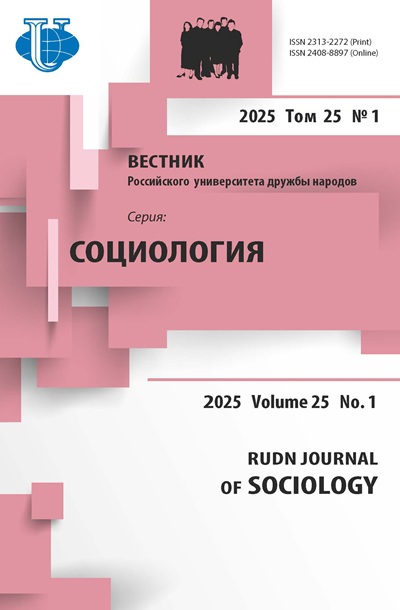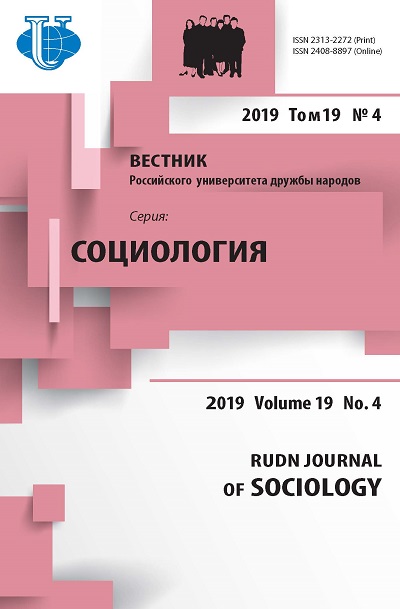International migration in border regions of Russia: Structural modeling of public attitudes
- Authors: Maximova SG1, Omelchenko DA1, Noyanzina OE1
-
Affiliations:
- Altai State University
- Issue: Vol 19, No 4 (2019)
- Pages: 737-755
- Section: Surveys, experiments, case studies
- URL: https://journals.rudn.ru/sociology/article/view/22095
- DOI: https://doi.org/10.22363/2313-2272-2019-19-4-737-755
Cite item
Full Text
Abstract
Changes in migration patterns and structure of international migration in Russia, its shift towards more transit forms in the interests of labor market and local conditions, together with serious economic and demographic losses, determine the need to change the migration policies. Such policies, if they focus on migrants without taking into account the public opinion of the host population, cannot ensure the balance of interests and stability in the region or realization of benefits of international migration. It is the choice of the host population that determines acculturation strategies and success of adaptation and integration of migrants. Based on the data of the sociological research conducted in 2018 in the border regions of Russia, the authors claim the existence of general evaluative factor of public attitudes and present the structural model of its determination consisting of institutional characteristics of regional society and social-structural and identification characteristics of respondents. According to the results of the research, the population of border regions believe that migration does not have any positive impact on the Russian economy and cannot compensate demographic losses, and underestimate risks of discrimination and social exclusion of labor migrants. In the majority of regions studied, the general perception of migration is affected by diasporal identities and comparison of the region with ‘the rest of Russia’. The subjective assessment of personal security, financial situation, migration experience and cultural factors are important for variability of indicators or regions. The study highlights the importance of fight against ethnic prejudices and migrantophobia and of positive public opinion for the effective migration policy reflecting national interests in terms of attracting foreign human and cultural capital.
About the authors
S G Maximova
Altai State University
Author for correspondence.
Email: svet-maximova@yandex.ru
доктор социологических наук, заведующая кафедрой психологии коммуникаций и психотехнологий
Lenina Prosp., 61, Barnaul, Russia, 656049D A Omelchenko
Altai State University
Email: daria.omelchenko@mail.ru
кандидат социологических наук, доцент кафедры психологии коммуникаций и психотехнологий
Lenina Prosp., 61, Barnaul, Russia, 656049O E Noyanzina
Altai State University
Email: noe@list.ru
кандидат социологических наук, доцент кафедры психологии коммуникаций и психотехнологий
Lenina Prosp., 61, Barnaul, Russia, 656049References
- Varshaver E.A. Teoriya kontakta: obzor [Contact theory: A review]. Monitoring Obshchestvennogo Mneniya: Ekonomicheskie i Sotsialnye Peremeny. 2015; 5 (In Russ.).
- Demintseva E.B., Mkrtchyan N.V., Florinskaya Yu.F. Migratsionnaya politika: diagnostika, vyzovy, predlozheniya [Migration Policy: Diagnostics, Challenges, Suggestions]. Moscow; 2018 (In Russ.).
- Dokhod ot prodazhi patentov trudovym migrantam sostavil 51 milliard rubley [The revenue from the sale of work patents to migrants is 51 milliard Rubles]. https://finance.rambler.ru/economics/ 39687453-dohod-ot-prodazhi-patentov-trudovym-migrantam-v-rf-v-2017-godu-sostavil-51-mlrd-rubley/?updated (In Russ.).
- Drobizheva L.M. Variatsii adaptatsionnogo potentsiala naseleniya k rastushchemu etnicheskomu mnogoobraziyu [Variations of the population’s potential for adapting to the increasing ethnic diversity]. Rossiya Reformiruyushchayasya. 2016; 14 (In Russ.).
- Informatsiya o sotsialno-ekonomicheskom polozhenii Rossii. Yanvar—noyabr 2018 goda [Information on the social-economic situation in the Russian Federation. January—November 2018]. http://www.gks.ru/free_doc/doc_2018/info/oper-11-2018.pdf (In Russ.).
- Omelchenko D.A., Maksimova S.G., Noyanzina O.E. Mezhdunarodnaya migratsiya i bezopasnost rossiyskikh regionov: statistichesky analiz i opyt postroeniya tipologii [International migration and security in Russian regions: Statistical analysis and an example of typology]. Society and Security Insights. 2018; 1 (In Russ.).
- Svodka osnovnykh pokazatelei deyatelnosti po migratsionnoi situatsii v Rossiiskoi Federatsii za yanvar—noyabr 2018 goda [Summary of key indicators of migration situation in the Russian Federation. January—November 2018]. https://xn--b1aew.xn--p1ai/Deljatelnost/statistics/migracionnaya/item/15252649 (In Russ.).
- Chislo zhenyashchikhsya “dlya grazhdanstva” priezzhikh vyroslo v 51 raz [The number of migrants married for citizenship has multiplied 51-fold]. https://www.pravda.ru/news/districts/1327527-citizenship (In Russ.).
- Shcherbakova E. Migratsiya v Rossii, itogi pervogo polugodiya 2018 goda [Migration in Russia, results of the first half of 2018. http://www.demoscope.ru/weekly/2018 /0783/barom05.php (In Russ.).
- Arlt D., Wolling J. Bias wanted! Examining people’s information exposure, quality expectations and bias perceptions in the context of the refugees’ debate among different segments of the German population. Communications. 2018; 43 (1).
- Binder J., Zagefka H., Brown R., Funke F., Kessler T., Mummendey A., Leyens J.-P. Does contact reduce prejudice or does prejudice reduce contact? A longitudinal test of the contact hypothesis among majority and minority groups in three European countries. Journal of Personality and Social Psychology. 2009; 96 (4).
- Bollen K.A. Structural equation models. Encyclopedia of Biostatistics. 2005; 7.
- Byrne D. An overview (and underview) of research and theory within the attraction paradigm. Journal of Social and Personal Relationships. 1997; 14 (3).
- Chen F.F. Sensitivity of goodness of fit indexes to lack of measurement invariance. Structural Equation Modeling. 2007; 14 (3).
- Cristobal E., Flavián C., Guinalíu M. Perceived e‐service quality (PeSQ). Managing Service Quality. 2007; 17 (3).
- Dimitrov D.M. Testing for factorial invariance in the context of construct validation. Measurement and Evaluation in Counseling and Development. 2010; 43 (2).
- Dixon J., Durrheim K. Contact and the ecology of racial division: Some varieties of informal segregation. British Journal of Social Psychology. 2003; 42 (1).
- Dovidio J.F., Gaertner S.L., Saguy T. Commonality and the complexity of “we”: Social attitudes and social change. Personality and Social Psychology Review. 2009; 13 (1).
- Esses V.M., Brochu P.M., Dickson K.R. Economic costs, economic benefits, and attitudes toward immigrants and immigration. Analyses of Social Issues and Public Policy. 2011; 12 (1).
- Esses V.M., Dovidio J.F., Jackson L.M. Armstrong T.L. The immigration dilemma: The role of perceived group competition, ethnic prejudice, and national identity. Journal of Social Issues. 2001; 57 (3).
- Guerra R., Gaertner S.L., António R., Deegan M. Do we need them? When immigrant communities are perceived as indispensable to national identity or functioning of the host society. European Journal of Social Psychology. 2015; 45 (7).
- Hirschfeld G., Von Brachel R. Multiple-Group confirmatory factor analysis in R-A tutorial in measurement invariance with continuous and ordinal indicators. Practical Assessment, Research & Evaluation. 2014; 19 (7).
- Hooper D., Coughlan J., Mullen M. Structural equation modelling: Guidelines for determining model fit. Journal of Business Research Methods. 2008; 6 (1).
- International Organization for Migration. World Migration Report. http://publications.iom.int/ books/world-migration-report-2018.
- Jorgensen T.D., Pornprasertmanit S., Schoemann A., Rosseel Y., Miller P., Quick C., Coffman D. Package ‘semTools’. 2018. http://ftp5.gwdg.de/pub/misc/cran/web/packages/semTools/ semTools.pdf.
- Kline R.B. Principles and Practice of Structural Equation Modeling. Guilford Publications; 2015.
- Louis W.R., Esses V.M., Lalonde R.N. National identification, perceived threat, and dehumanization as antecedents of negative attitudes toward immigrants in Australia and Canada. Journal of Applied Social Psychology. 2013; 43.
- Meade A.W., Johnson E.C., Braddy P.W. The utility of alternative fit indices in tests of measurement invariance. Academy of Management Proceedings. 2006; 1.
- Meredith W. Measurement invariance, factor analysis and factorial invariance. Psychometrika. 1993; 58 (4).
- Millsap R.E. Statistical Approaches to Measurement Invariance. Routledge; 2012.
- Motyl M., Iyer R., Oishi S., Trawalter S., Nosek B.A. How ideological migration geographically segregates groups. Journal of Experimental Social Psychology. 2014; 51.
- Schwartz S.J., Vignoles V.L., Brown R., Zagefka H. The identity dynamics of acculturation and multiculturalism. Oxford Handbook of Multicultural Identity. Oxford University Press; 2014.
- Steinmetz H., Schmidt P., Tina-Booh A., Wieczorek S., Schwartz S.H. Testing measurement invariance using multigroup CFA: Differences between educational groups in human values measurement. Quality & Quantity. 2008; 43 (4).
- Stephan C.W., Stephan W.C., Demitrakis K.M., Yamada A.M., Clason D.L. Women’s attitudes toward men. An Integrated Threat Theory approach. Psychology of Women Quarterly. 2000; 24 (1).
- Stephan W.G., Renfro C.L. The role of threats in intergroup relation. From Prejudice to Intergroup Emotions. Psychology Press; 2002.
- Tartakovsky E., Walsh S.D. Testing a new theoretical model for attitudes toward immigrants. Journal of Cross-Cultural Psychology. 2015; 47 (1).
- Hanefi Topal M., Ózer U., Dokuzlu E. Public perception of Syrian refugees in Turkey: An empirical explanation using extended integrative threat theory. Problemy Polityki Społecznej. Studia i Dyskusje. 2017; 38 (3).
- Van Oudenhoven J.P., Ward C., Masgoret A.-M. Patterns of relations between immigrants and host societies. International Journal of Intercultural Relations. 2006; 30 (6).
- Ward C., Masgoret A.M. The Experiences of International Students in New Zealand. Report on the Results of a National Survey. Wellington; 2004.
- World Bank. Migration and Remittances Data. http://www.worldbank.org/en/topic/migration remittancesdiasporaissues/brief/migration-remittances-data.
- Wu A.D., Li Z., Zumbo B.D. Decoding the meaning of factorial invariance and updating the practice of multi-group confirmatory factor analysis: A demonstration with TIMSS data. Practical Assessment, Research and Evaluation. 2007; 12 (3).
- Xu K. Multiple Group Measurement: Invariance Analysis in Lavaan. Cambridge Mass; 2012.














